At right, a gunner's view from Fort Balaguier looking north past Fort L'Eguilette into La Petite Rade.
The 24-year-old Captain Napoleone Buonaparte was appointed artillery commander of the besieging Republican army on 16 September.
It was here that the future Emperor first demonstrated some of the qualities that would mark him out as a soldier of genius: As a strategist, he perceived that the maritime supply lifeline was crucial to the enemy's defense, and was its weakest link. His grasp of terrain, the "coup d'oeil" that would enable him to exploit the peculiarities of so many future battlefields, informed him that the hill of Le Caire and its dependent coastline would allow his artillery to dominate the harbor.
Having formulated and gained approval for his plan to seize these positions, he demonstrated his tremendous capacity for work, his expertise as an artilleryman, and his personal leadership and courage as he risked death daily in the forward batteries.
Forts Mulgrave, Balaguier, and L'Eguilette were successfully stormed on 17 December 1793. Captain Buonaparte had a horse killed under him and sustained a bayonet wound to the thigh during the assault. Under the threat of Buonaparte's guns, the Royal Navy hastily evacuated the harbor on the night of 18-19 December 1793, and the city surrendered the following morning.
A visit to the associated sites is rewarding for the insight you gain into the three-dimensional relationships of the battlefield features, particularly the hill of Le Caire.
The hill is unimposing seen from a distance, but it is literally breathtaking to walk to one of the crests and suddenly see the harbor appear below you like a bathtub full of toys.
The post-1793 French appreciated the continuing importance of the position, and built a fine masonry fort to replace the earthwork Fort Mulgrave. "Fort Napoleon" still stands (see at right), its courtyard now used as a concert venue. The slopes of Le Caire are now parkland, with the advantage of pleasant shady paths, and the disadvantage of a luxurious growth of trees obscuring many of the viewpoints available in 1793.
No wonder "les anglais" scurried off with their tails between their legs when Buonaparte's gunners could combine the short-range direct fire of the shore forts with the plunging fire from Fort Mulgrave!
Chandler, David G. Dictionary of the Napoleonic Wars. Simon & Schuster, New York, 1993.
More Toulon
This article appears in MagWeb (Magazine Web) on the Internet World Wide Web.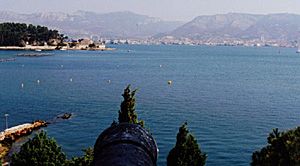 The Royalists of Toulon revolted against the French Republic on 27 August 1793, admitting an army of British, Spanish, and Neapolitan troops sustained and supported by the Mediterranean squadron of the Royal Navy under Admiral Hood.
The Royalists of Toulon revolted against the French Republic on 27 August 1793, admitting an army of British, Spanish, and Neapolitan troops sustained and supported by the Mediterranean squadron of the Royal Navy under Admiral Hood.
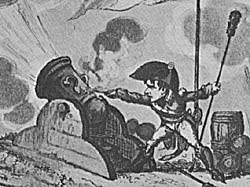 "Napoleon Working the Gun at Toulon" by George Cruikshank. (from Chandler, Napoleon pg. 19.
"Napoleon Working the Gun at Toulon" by George Cruikshank. (from Chandler, Napoleon pg. 19.
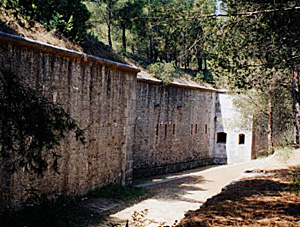
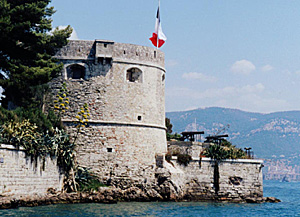 Down by the shore, the Seventeenth-Century Fort Balaguier (see at right) has been beautifully preserved and is open to visitors for a small fee. Standing by one of the heavy guns and peering through the embrasure across the harbor gives a wonderful sense of the advantage of a solid stone-built shore emplacement with red-hot shot against a fragile wooden-hulled fleet.
Down by the shore, the Seventeenth-Century Fort Balaguier (see at right) has been beautifully preserved and is open to visitors for a small fee. Standing by one of the heavy guns and peering through the embrasure across the harbor gives a wonderful sense of the advantage of a solid stone-built shore emplacement with red-hot shot against a fragile wooden-hulled fleet. 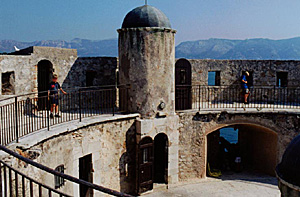 The Toulon area has been overshadowed as a tourist destination by the charms of Marseille to the west, and the Riviera to the east, but sun-seekers as well as militaria enthusiasts can be happy here. On the isthmus a couple of kilometers south of Fort Balaguier is the pleasant beach resort of Les Sablettes, part of the Commune of La Seyne-sur-Mer, with many nice-looking hotels.
There is also a large campground (Camping Les Pins) within walking distance of the beach.
Each morning, a bakery van from the local boulangerie pulls up by the camp office to sell fragrant baguettes, croissants, brioches…Only in France, my friends!
The Toulon area has been overshadowed as a tourist destination by the charms of Marseille to the west, and the Riviera to the east, but sun-seekers as well as militaria enthusiasts can be happy here. On the isthmus a couple of kilometers south of Fort Balaguier is the pleasant beach resort of Les Sablettes, part of the Commune of La Seyne-sur-Mer, with many nice-looking hotels.
There is also a large campground (Camping Les Pins) within walking distance of the beach.
Each morning, a bakery van from the local boulangerie pulls up by the camp office to sell fragrant baguettes, croissants, brioches…Only in France, my friends!
Bibliography
Chandler, David Napoleon Saturday Review Press, New York, 1973.
Chandler, David G. The Campaigns of Napoleon. Weidenfeld & Nicolson, London, 1966.
Siege of Toulon, 1793
Map of Forts Around Toulon (slow: 108K)
Toulon Outer and Inner Harbor Photos (slow: 113K)
Back to List of Battlefields
Back to Travel Master List
Back to MagWeb Master List of Magazines
© Copyright 2000 by Bill Peterson.
Other military history articles and gaming articles are available at http://www.magweb.com